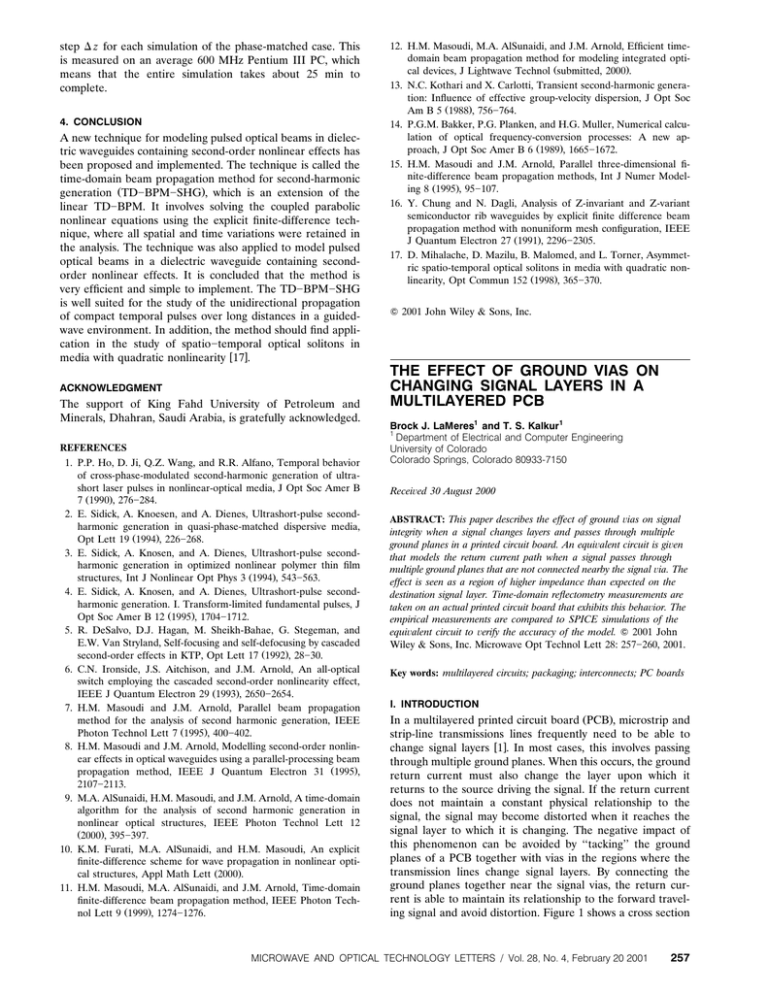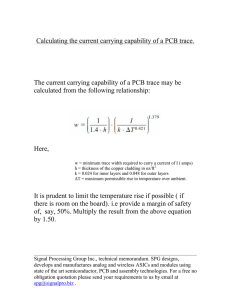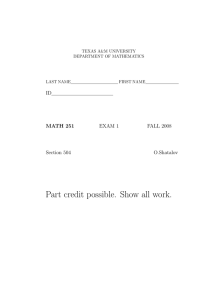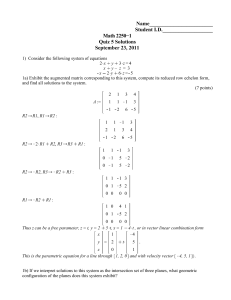the effect of ground vias on changing signal
advertisement

step ⌬ z for each simulation of the phase-matched case. This is measured on an average 600 MHz Pentium III PC, which means that the entire simulation takes about 25 min to complete. 4. CONCLUSION A new technique for modeling pulsed optical beams in dielectric waveguides containing second-order nonlinear effects has been proposed and implemented. The technique is called the time-domain beam propagation method for second-harmonic generation ŽTD᎐BPM᎐SHG., which is an extension of the linear TD᎐BPM. It involves solving the coupled parabolic nonlinear equations using the explicit finite-difference technique, where all spatial and time variations were retained in the analysis. The technique was also applied to model pulsed optical beams in a dielectric waveguide containing secondorder nonlinear effects. It is concluded that the method is very efficient and simple to implement. The TD᎐BPM᎐SHG is well suited for the study of the unidirectional propagation of compact temporal pulses over long distances in a guidedwave environment. In addition, the method should find application in the study of spatio᎐temporal optical solitons in media with quadratic nonlinearity w17x. ACKNOWLEDGMENT The support of King Fahd University of Petroleum and Minerals, Dhahran, Saudi Arabia, is gratefully acknowledged. REFERENCES 1. P.P. Ho, D. Ji, Q.Z. Wang, and R.R. Alfano, Temporal behavior of cross-phase-modulated second-harmonic generation of ultrashort laser pulses in nonlinear-optical media, J Opt Soc Amer B 7 Ž1990., 276᎐284. 2. E. Sidick, A. Knoesen, and A. Dienes, Ultrashort-pulse secondharmonic generation in quasi-phase-matched dispersive media, Opt Lett 19 Ž1994., 226᎐268. 3. E. Sidick, A. Knosen, and A. Dienes, Ultrashort-pulse secondharmonic generation in optimized nonlinear polymer thin film structures, Int J Nonlinear Opt Phys 3 Ž1994., 543᎐563. 4. E. Sidick, A. Knosen, and A. Dienes, Ultrashort-pulse secondharmonic generation. I. Transform-limited fundamental pulses, J Opt Soc Amer B 12 Ž1995., 1704᎐1712. 5. R. DeSalvo, D.J. Hagan, M. Sheikh-Bahae, G. Stegeman, and E.W. Van Stryland, Self-focusing and self-defocusing by cascaded second-order effects in KTP, Opt Lett 17 Ž1992., 28᎐30. 6. C.N. Ironside, J.S. Aitchison, and J.M. Arnold, An all-optical switch employing the cascaded second-order nonlinearity effect, IEEE J Quantum Electron 29 Ž1993., 2650᎐2654. 7. H.M. Masoudi and J.M. Arnold, Parallel beam propagation method for the analysis of second harmonic generation, IEEE Photon Technol Lett 7 Ž1995., 400᎐402. 8. H.M. Masoudi and J.M. Arnold, Modelling second-order nonlinear effects in optical waveguides using a parallel-processing beam propagation method, IEEE J Quantum Electron 31 Ž1995., 2107᎐2113. 9. M.A. AlSunaidi, H.M. Masoudi, and J.M. Arnold, A time-domain algorithm for the analysis of second harmonic generation in nonlinear optical structures, IEEE Photon Technol Lett 12 Ž2000., 395᎐397. 10. K.M. Furati, M.A. AlSunaidi, and H.M. Masoudi, An explicit finite-difference scheme for wave propagation in nonlinear optical structures, Appl Math Lett Ž2000.. 11. H.M. Masoudi, M.A. AlSunaidi, and J.M. Arnold, Time-domain finite-difference beam propagation method, IEEE Photon Technol Lett 9 Ž1999., 1274᎐1276. 12. H.M. Masoudi, M.A. AlSunaidi, and J.M. Arnold, Efficient timedomain beam propagation method for modeling integrated optical devices, J Lightwave Technol Žsubmitted, 2000.. 13. N.C. Kothari and X. Carlotti, Transient second-harmonic generation: Influence of effective group-velocity dispersion, J Opt Soc Am B 5 Ž1988., 756᎐764. 14. P.G.M. Bakker, P.G. Planken, and H.G. Muller, Numerical calculation of optical frequency-conversion processes: A new approach, J Opt Soc Amer B 6 Ž1989., 1665᎐1672. 15. H.M. Masoudi and J.M. Arnold, Parallel three-dimensional finite-difference beam propagation methods, Int J Numer Modeling 8 Ž1995., 95᎐107. 16. Y. Chung and N. Dagli, Analysis of Z-invariant and Z-variant semiconductor rib waveguides by explicit finite difference beam propagation method with nonuniform mesh configuration, IEEE J Quantum Electron 27 Ž1991., 2296᎐2305. 17. D. Mihalache, D. Mazilu, B. Malomed, and L. Torner, Asymmetric spatio-temporal optical solitons in media with quadratic nonlinearity, Opt Commun 152 Ž1998., 365᎐370. 䊚 2001 John Wiley & Sons, Inc. THE EFFECT OF GROUND VIAS ON CHANGING SIGNAL LAYERS IN A MULTILAYERED PCB Brock J. LaMeres1 and T. S. Kalkur1 1 Department of Electrical and Computer Engineering University of Colorado Colorado Springs, Colorado 80933-7150 Recei¨ ed 30 August 2000 ABSTRACT: This paper describes the effect of ground ¨ ias on signal integrity when a signal changes layers and passes through multiple ground planes in a printed circuit board. An equi¨ alent circuit is gi¨ en that models the return current path when a signal passes through multiple ground planes that are not connected nearby the signal ¨ ia. The effect is seen as a region of higher impedance than expected on the destination signal layer. Time-domain reflectometry measurements are taken on an actual printed circuit board that exhibits this beha¨ ior. The empirical measurements are compared to SPICE simulations of the equi¨ alent circuit to ¨ erify the accuracy of the model. 䊚 2001 John Wiley & Sons, Inc. Microwave Opt Technol Lett 28: 257᎐260, 2001. Key words: multilayered circuits; packaging; interconnects; PC boards I. INTRODUCTION In a multilayered printed circuit board ŽPCB., microstrip and strip-line transmissions lines frequently need to be able to change signal layers w1x. In most cases, this involves passing through multiple ground planes. When this occurs, the ground return current must also change the layer upon which it returns to the source driving the signal. If the return current does not maintain a constant physical relationship to the signal, the signal may become distorted when it reaches the signal layer to which it is changing. The negative impact of this phenomenon can be avoided by ‘‘tacking’’ the ground planes of a PCB together with vias in the regions where the transmission lines change signal layers. By connecting the ground planes together near the signal vias, the return current is able to maintain its relationship to the forward traveling signal and avoid distortion. Figure 1 shows a cross section MICROWAVE AND OPTICAL TECHNOLOGY LETTERS / Vol. 28, No. 4, February 20 2001 257 Figure 1 Cross section of a signal changing layers in a PCB of a signal changing layers on a printed circuit board while passing through two ground planes. In the literature, most of the research was confined to a single ground via in a PCB w2᎐4x. This paper investigates the effect of ground vias in a printed circuit board. This is accomplished by taking time-domain reflectometry ŽTDR. measurements on a printed circuit board trace that passes through multiple ground planes that do not have ground via connections near the signal via. An equivalent circuit is then developed to show the effect of not connecting the ground planes together near the signal via. This effect is modeled by including an inductance in the ground return path of the transmission line on the destination signal layer. The ground planes of the PCB are then tacked together using pseudoground vias, and the TDR measurements are repeated. The measurements will show that, by tacking the ground planes together near the signal via, the negative effect of an impeded return current can be avoided. The next section gives the theoretical background for this investigation. the new ground plane. If the ground planes are connected together with vias in the region where the signal changes layers, the amount of time it takes for the equal and opposite charge to be developed is negligible. This is because the charge can be drawn from the point immediately preceding the rising edge of the pulse through the ground vias. If the ground planes are not connected together near the region where the signal changes layers, the equal and opposite charge must be drawn from a point further away. The time it takes for the charge to be developed may not be negligible, and could cause the rise time of the pulse’s edge to be degraded. This phenomenon can also be described by saying that the trace on the layer to which the signal is changing has a higher initial impedance than that of the original layer. The higher impedance of the destination transmission line can be modeled by including an inductance in the ground current return path of the transmission-line model. This is an accurate representation of the actual response of the system because the model shows a finite time delay in developing the appropriate negative charge in the ground plane. Figure 3 shows the TDR experimental setup and equivalent circuit of a PCB trace changing signal layers through multiple ground planes without sufficient ground-plane connections near the signal via. The parasitic effect of the signal via is modeled as a discrete capacitance. The series inductance of the destination signal layer is increased due to the inclusion of the inductance in the return current path Ž L⬙ .. Equation Ž1. w5x gives the definition of characteristic impedance for a lossless transmission line. This equation shows that the characteristic impedance is proportional to the inductance of the line, and that an increase in inductance will result in an increase in impedance. Z0 s II. THEORY When a step pulse propagates down a transmission line on a printed circuit board, the wavefront sequentially charges up every point on the line to the final steady-state voltage of that signal. When a point on the transmission line is charged, an equal and opposite charge is developed in the ground plane to which the signal is referenced. In high-speed transport systems, the time it takes to charge the line is of great importance to the overall speed of the system. One of the factors that limits the speed at which a point on the line can be charged is the time it takes for the equal and opposite charge in the ground plane to be developed. The development of this equal and opposite charge in the ground plane, also known as the return current, can be slowed when a signal changes layers in a PCB. Figure 2 shows the return current charge as a step pulse propagates down a transmission line above a ground plane. When a signal changes layers in a printed circuit board and passes through multiple ground planes, the signal voltage is referenced to a new ground plane. There is a finite amount of time for the equal and opposite charge to be developed in Figure 2 258 Step pulse traveling above a ground plane ( L⬘ C⬘ Ž1. where L⬘ s inductance per unit length and C⬘ s capacitance per unit length. III. EMPIRICAL DATA This section shows the time-domain reflectometry measurements made on a printed circuit board microstrip transmission line that changes signal layers and passes through multiple ground planes. Figure 4 shows the test PCB on which the measurements were taken. Initially, the ground planes are only connected together around the edges of the board. When the signal trace changes layers in the middle of the board, there is a finite amount of Figure 3 Equivalent circuit of a transmission line changing layers on a PCB Žwithout ground-plane connections near the signal via. MICROWAVE AND OPTICAL TECHNOLOGY LETTERS / Vol. 28, No. 4, February 20 2001 Figure 4 Test printed circuit board time for the equal and opposite charge to be developed in the new ground plane to which the signal is referenced. This effect will make the destination transmission line appear to have a higher initial impedance than the original PCB trace when performing TDR measurements. Figure 5 shows the results of the TDR measurement. The original trace has a characteristic impedance of 75 ⍀. After changing layers using the signal via Žshown as a capacitive discontinuity., the signal encounters an impedance greater than 75 ⍀. This is due to not having nearby connections between the multiple ground planes. In this measurement, the following electrical parameters were extracted: Figure 6 TDR measurements on a trace after proper ground-plane connections Z0 of the original PCB trace s 75 ⍀ C of the signal via s 375 pF ZX0 of the destination PCB trace s 77 ⍀ L⬙, excess inductance in return current path s 400 pH. The next TDR measurement was taken on the same trace after the ground planes were connected together near the signal via using pseudoground vias. This was accomplished by drilling holes into the PCB, and then inserting metal pins to mimic ground via connections. Figure 6 shows the TDR measurement of the same trace after the connection of the ground planes. Also shown is the TDR measurement of the trace before the ground vias were in place. This clearly shows that connecting the ground planes together near the signal via reduces the negative effect of a delayed return current. The equivalent circuit of the printed circuit board trace changing layers without the proper connection of ground planes ŽFig. 3. was simulated to verify its functionality. The same circuit, without including the inductance present in the ground return path of the destination trace, was simulated to show the ideal case. Theoretically, the TDR measurements taken on the PCB trace after the pseudoground vias were in place should match the ideal case. Figure 7 shows the simula- Figure 5 TDR measurements on a trace without proper ground connections Figure 7 Equivalent circuit simulation results tion results of the equivalent circuits for both the pre- and postconnection of ground planes near the signal via. Also shown are in the empirical TDR data for both cases. This figure shows that the simulation data closely match the empirical data for both cases. This indicates that including an inductance in the ground return path of the destination PCB trace in the equivalent circuit is an accurate model for an impeded return current path. IV. CONCLUSION This paper investigated the effect of return current on the signal integrity of a signal changing layers on a printed circuit board passing through multiple ground planes without a proper connection between the ground planes. Time-domain reflectometry measurements showed that, by connecting the ground planes together with vias in the region where a signal changes layers, the negative effects of an impeded return current can be avoided. An equivalent circuit was also presented to model the effect of a return current that has a finite time delay in developing the necessary negative charge in the ground plane to support the incident signal. By including an inductance in the ground return current path of the transmission-line model of a PCB trace, the behavior of the impeded return current can be accurately modeled. The simulation results were compared to the empirical data to verify the equivalent circuit’s accuracy. When designing a high-speed transport system using printed circuit boards, signal integrity is of great importance to the overall speed of that system. Any distortion added to a signal can lead to slower rise times and a reduction of performance for that system. This paper has shown that distortion added by an impeded ground return current due to MICROWAVE AND OPTICAL TECHNOLOGY LETTERS / Vol. 28, No. 4, February 20 2001 259 passing through multiple ground planes in a PCB can be avoided by including vias that connect the multiple ground planes together near the region where the signal changes layers. REFERENCES 1. G.R. Blackwell, ‘‘Circuit boards,’’ The electronic packaging handbook, G. R. Blackwell ŽEditor., IEEE Press, New York, 1999. 2. S. Papatheodorou, R.F. Harrington, and J.R. Mautz, The equivalent circuit of a microstrip crossover in a dielectric substrate, IEEE Trans Microwave Theory Tech, 38 Ž1990., 135᎐140. 3. M.E. Goldfarb and R.A. Pucel, Modeling via hole grounds in microstrip, IEEE Microwave Guided Wave Lett 1 Ž1991., 135᎐137. 4. P.A. Kok and D. DeZutter, Scalar magnetic potential approach to the prediction of excess inductance of a grounded via and vias through a hole in grounded plane, IEEE Trans Microwave Theory Tech 42 Ž1994., 1229᎐1237. 5. F.T. Ulaby, Fundamentals of applied electromagnetics, PrenticeHall, Englewood Cliffs, NJ, 1997. 䊚 2001 John Wiley & Sons, Inc. ORTHOGONAL CIRCULAR POLARIZATION AXICON BEAM SPLITTER Mansour K. Mansour1 and Mohammed A. Habli 2 1 Department of Electronics Engineering Higher Colleges of Technology AlAin, United Arab Emirates 2 Department of Electrical Engineering United Arab Emirates University AlAin, United Arab Emirates Recei¨ ed 28 August 2000 ABSTRACT: The design of an orthogonal circular polarization axicon beam splitter (OCPABS) that generates orthogonal circular polarization states (OCPS) is presented. The OCPABS consists of an absorbing V-shaped substrate coated with a transparent single-layer thin film. The power reflectances range between 25.19 and 56.24% in the infrared (IR), ¨ isible, and ultra¨ iolet (UV) light regions. 䊚 2001 John Wiley & Sons, Inc. Microwave Opt Technol Lett 28: 260᎐265, 2001. Key words: orthogonal circular polarization states; beam splitter; IR to UV light regions; single-layer coating; absorbing substrate 1. INTRODUCTION Recently, we have introduced a reflector axicon polarization beam splitter ŽAPBS. that operates in the UV range and a polarization beam splitter for visible light ŽPBS᎐VL. w1᎐2x. Both devices consist of an absorbing V-shaped substrate coated with thin-film layers. In this paper, we introduce the orthogonal circular polarization axicon beam splitter ŽOCPABS.. The OCPABS is a device that can generate orthogonal circular polarization states ŽOCPS.. Azzam w3x generated spatial OCPS in the IR and visible region ranges with power reflectances that are less than or equal to 33.35%. The OCPABS presented in this paper operates in a wide spectrum range, namely, the IR, visible, and UV light regions with power reflectances up to 56.24%. the horizontal plane, respectively. The q plane reflects the right-handed circular polarization state, while the y plane reflects the left-handed circular polarization state. A plane wave of monochromatic light traveling in a transparent medium of refractive index N0 is incident at an angle 0q and at an angle 0y on the q and y planes, respectively. The incident light is linearly polarized at 45⬚ azimuth with respect to the plane of incidence. Both surfaces are made of an absorbing substrate of complex refractive index N2 s n 2 y jk 2 coated by a transparent thin film of refractive index N1 . The subscript is used to refer to the thin film on the q and y surfaces. The film has a uniform thickness d over the corresponding total area of the substrate. The media of incidence, film, and substrate, denoted by 0, 1, and 2, respectively, over both planes, are assumed to be linear, homogeneous, isotropic, and nonmagnetic, and are separated by parallel᎐plane interfaces. The complex amplitude reflection coefficient of the film᎐substrate system is given by w4x R ¨ r s Ž r 01¨ r q r 12 ¨ r X . r Ž 1 q r 01¨ r r 12 ¨ r X . where ¨ is used to indicate p and s polarizations, is used to indicate the q and y planes, where D s 2 260 X s eyj2 Ž2. s drD 0 Ž3. Ž N12 y N02 sin 2 0 . y1r2 . Ž4. is the normalized film thickness, D is the film thickness period, and is the free-space wavelength of the light incident on the structure. r 01¨ r and r 12 ¨ r are Fresnel’s reflection coefficients of the 01 and 12 interfaces of the q and y planes for the p and s polarizations given by r 01 p r s tan Ž 0 y 1 . Ž5. tan Ž 0 q 1 . r 01sr s y sin Ž 0 y 1 . Ž6. sin Ž 0 q 1 . where the indexes of refraction and the angles on both sides of the interface are related by Snell’s law as N0 sin Ž 0 . s N1 sin Ž 1 . . Ž7. Similar expressions can be written for the 1᎐2 interface: r 12 p r s tan Ž 1 y 2 . Ž8. tan Ž 1 q 2 . r 12 sr s y sin Ž 1 y 2 . sin Ž 1 q 2 . . Ž9. The generation of the orthogonal Žright- and left-handed. circular polarization states requires that s 2. PROBLEM DESCRIPTION Consider the reflective polarization beam splitter structure shown in Figure 1. The structure consists of two planes, the q plane and the y plane that make angles q and y with Ž1. R pr R sr s "j Ž 10. where j 2 s y1. The qs qj and ys yj are used to generate the right-handed and left-handed circular polarization states, respectively. MICROWAVE AND OPTICAL TECHNOLOGY LETTERS / Vol. 28, No. 4, February 20 2001





